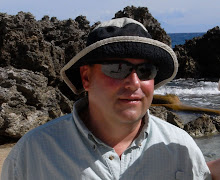 |
| Group at western tip of Roatan |
 |
| Nurse Shark with Sharksucker |
 |
| Lettuce Sea Slug |
 |
| Nassau Grouper |
 |
| Val and his hydroponic facilit |
The day started out with a trip to Blue Harbor hydroponic farm, where we met with Dr. Val Eylands, an agronomist who left his faculty position in the US to start a new venture in Roatan. Val provided an inspiring tour of his operation, comparing the hydroponic operation to traditional farming. As he pointed out, he can produce a similar crop of lettuce using 10% of the land, water and pesticides of traditional farms. Although hydroponics can be labor intensive, he has empowered local women by providing them jobs and a chance to improve their standards of living. The teachers were thrilled to find out that the lettuce they have been enjoying in their daily salads comes from Val’s farm….fresh to the kitchen at AKR.
After the farm trip, the group headed to the intertidal area where they got to see snails, anemones, algae and small fishes that make their home in the tidepools and under the coral rubble. The teachers walked along a wall at a newly built resort and were able to see that the construction material was huge chunks of dead corals that had washed up on shore. They were actually able to pick out brain, star and staghorn coral formations from the wall. In many of the islands of the Caribbean, coral rubble is used for road and building construction. The calcium carbonate skeletons provide a concrete-like building material that provides strength and support.
The afternoon dive/snorkel really made it a “terrific Tuesday” as the divers encountered an 8’ nurse shark resting between two coral outcroppings. As the nurse shark rested on the bottom, it was easy to see its gill flaps as the cartilaginous fish pumped water over its gills. Although many sharks need to keep swimming in order to force water over their gills, bottom-dwelling nurse sharks can breathe as they remain in one place. The nurse shark gets its name from the suckling or nursing sound that they make as they suck up bottom dwelling prey like crabs and mollusks. The nurse shark is pictured with a remora, or shark-sucker that scrapes off parasites from the shark’s body and gills. This symbiotic relationship provides a cleaning service for the shark and a free meal for the remora. The dive and snorkel also provided views of a Nassau grouper with its brown body bands and an odd-looking trunkfish with it triangular shaped box-like body. The delicate lettuce sea slug proved to be the most beautiful sighting of the dive, with its frilly gills and colorful markings. These nudibranchs are often overlooked by divers who may not keep a watchful eye out for the colorful invertebrates.

























